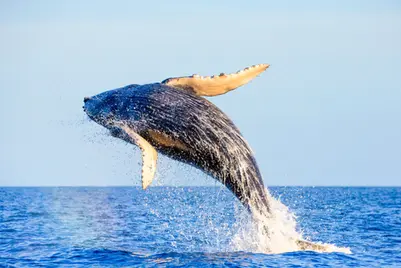
HUMPBACK WHALE
Megaptera Novaeangliae

Order
Mysticeti
Family
Balaenopteridae
Humpback whales live up to around 50 to 80 years. They measure between 11 and 18 meters in length and weigh between 24 and 40 tons.
Humpback whales feed mainly on krill and small, shallow-water fish, which they filter using their baleen plates in polar waters before beginning their migration. They build up energy reserves in polar regions to prepare for the long migration and breeding season, during which they do not eat despite the significant effort involved.
Humpback whales are great migrators. They feed in cold, polar waters, then begin a migration spanning tens of thousands of kilometers to reach the warm, tropical waters of the Caribbean by December, which serve as their breeding grounds.
This is the time of year when humpback whales can be observed in Guadeloupe—from December to May.
Humpback whales can give birth to a calf every two to three years, in tropical waters, after a gestation period of 11 to 12 months. During this time, they feed in cold waters.
There is still some uncertainty, but the famous, complex, and powerful whale songs that can be heard several kilometers underwater are believed to be related to reproduction. Males are thought to produce these songs during the breeding season to attract females.
- Source : AGOA
Head
Quite narrow and flattened, covered with protrusions.
Dorsal Fin & Fins
Dorsal fin positioned on a hump. Caudal fin with individual shape and coloration, long white pectoral fins.
Blow
Bushy thanks to its double vent.
Swimming sequence
Before sounding, the back, dorsal fin, and caudal peduncle arch sharply.
Coloration
Dark coat







